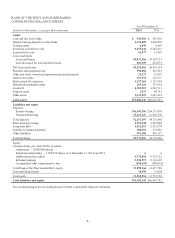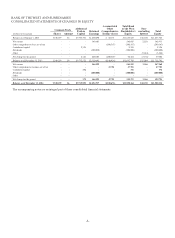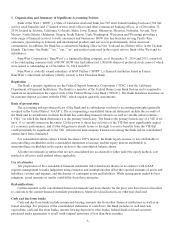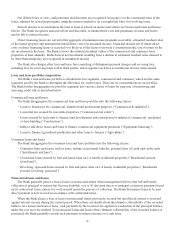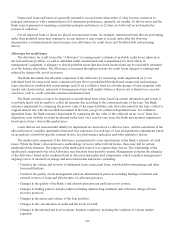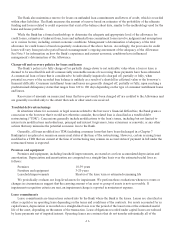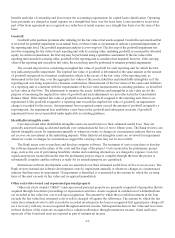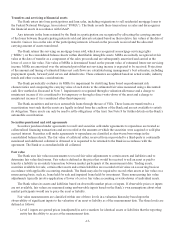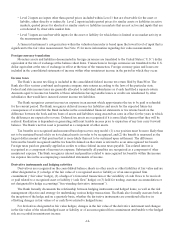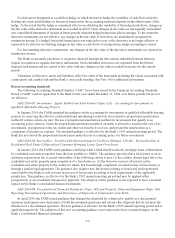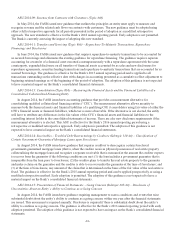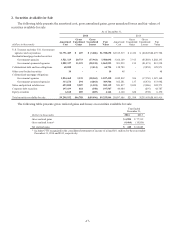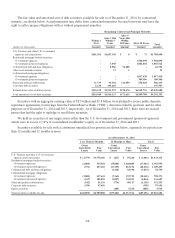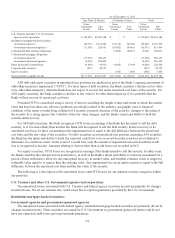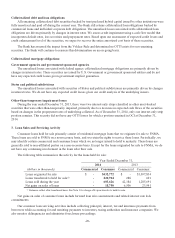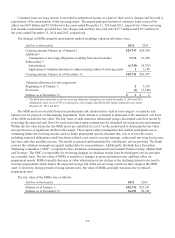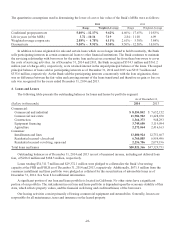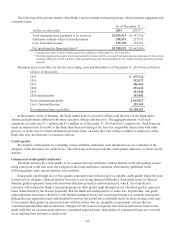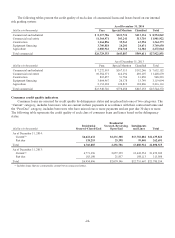Bank of the West 2014 Annual Report Download - page 16
Download and view the complete annual report
Please find page 16 of the 2014 Bank of the West annual report below. You can navigate through the pages in the report by either clicking on the pages listed below, or by using the keyword search tool below to find specific information within the annual report.• Level 2 inputs are inputs other than quoted prices included within Level 1 that are observable for the asset or
liability, either directly or indirectly. Level 2 inputs include quoted prices for similar assets or liabilities in active
markets, quoted prices for identical or similar assets or liabilities in markets that are not active and inputs that are
corroborated by observable market data.
• Level 3 inputs are unobservable inputs for the asset or liability for which there is limited or no market activity at
the measurement date.
A financial instrument’s categorization within the valuation hierarchy is based upon the lowest level of input that is
significant to the fair value measurement. See Note 15 for more information regarding fair value measurements.
Foreign currency translation
Monetary assets and liabilities denominated in foreign currencies are translated to the United States (“U.S.”) dollar
equivalent at the rate of exchange at the balance sheet dates. Transactions in foreign currencies are translated to the U.S.
dollar equivalent at the rate of exchange in effect at the time of the transaction. Foreign currency gains and losses are
included in the consolidated statements of income within other noninterest income in the period in which they occur.
Income taxes
The Bank’s income tax filing is included in the consolidated federal income tax return filed by BancWest. The
Bank also files various combined and separate company state returns according to the laws of the particular state.
Federal and state income taxes are generally allocated to individual subsidiaries as if each had filed a separate return.
Amounts equal to income tax benefits of those subsidiaries having taxable losses or credits are reimbursed by other
subsidiaries that would have incurred current income tax liabilities.
The Bank recognizes current income tax expense in an amount which approximates the tax to be paid or refunded
for the current period. The Bank recognizes deferred income tax liabilities and assets for the expected future tax
consequences of events that the Bank includes in the consolidated financial statements or tax returns based on the
difference between the book and tax bases of assets and liabilities using enacted tax rates in effect for the years in which
the differences are expected to reverse. Deferred tax assets are recognized if it is more likely than not that they will be
realized. Realization is dependent on generating sufficient taxable income prior to expiration of any loss carry forward
balance. The Bank’s net tax asset is presented as a component of other assets.
Tax benefits are recognized and measured based upon a two-step model: (1) a tax position must be more likely than
not to be sustained based solely on its technical merits in order to be recognized, and (2) the benefit is measured as the
largest dollar amount of that position that is more likely than not to be sustained upon settlement. The difference
between the benefit recognized and the tax benefit claimed on the return is referred to as an unrecognized tax benefit.
Foreign taxes paid are generally applied as credits to reduce federal income taxes payable. Tax-related interest is
recognized as a component of income tax expense. Substantially all penalties are recognized as a component of other
noninterest expense. The Bank recognizes interest and penalties related to unrecognized tax benefits within the income
tax expense line in the accompanying consolidated statements of income.
Derivative instruments and hedging activities
Derivatives are recognized on the consolidated balance sheets as other assets or other liabilities at fair value and are
either designated as (1) a hedge of the fair value of a recognized asset or liability or of an unrecognized firm
commitment (“fair value” hedge), (2) a hedge of a forecasted transaction or the variability of cash flows to be received
or paid related to a recognized asset or liability (“cash flow” hedge) or (3) held for trading, customer accommodation or
not designated for hedge accounting (“free-standing derivative instrument”).
The Bank formally documents the relationship between hedging instruments and hedged items, as well as the risk
management objective and strategy for undertaking various hedge transactions. The Bank also formally assesses both at
the inception of the hedge and on a quarterly basis, whether the derivative instruments are considered effective in
offsetting changes in fair values of or cash flows related to hedged items.
For derivatives designated as fair value hedges, changes in the fair value of the derivative instrument and changes
in the fair value of the related hedged asset or liability or of an unrecognized firm commitment attributable to the hedged
risk are recorded in noninterest income.
-14-


